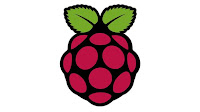Previous sections of this story:
So - you've bought your Raspberry Pi and installed an operating system on it.
Now to switch it on, all you need to do it plug it in. The RPi doesn't have an on-and-off switch, as such. You just plug in the micro-USB cable and it switches on.
If you're using an HDMI connection to a TV (or other HDMI monitor), make sure you've got it plugged in before you start it up. If Raspbian doesn't detect a connection on the HDMI port, it "fails-over" to the Composite Video port. Once that has happened, it's difficult, if not impossible to get the RPi to switch back over to the HDMI port, for video, without completely restarting it.
Configuration
Make sure you've got your keyboard plugged into one of the USB connections in your RPi, because... the first time you see it boot up (assuming you installed Raspbian) you will see this screen. |
This is the "raspi-config" screen.
On first boot-up, I used the "expand_rootfs" option - so that the whole of my SD card was available to the root partition. You will probably want to do this too, especially if you have a card bigger than the minimum required 2Gb.
I also enabled the SSH server, using this tool. I found this invaluable later on. It was much simpler to SSH into my RPi from my other computers on our home network, than it was to keep it plugged into our main television. I now have the RPi set-up so that I can SSH in from my Android Phone, using PaderSyncSSH. I tried a few different SSH clients - but this was the only one that really worked (easy control key commands, intuitive SSH interface etc.). It costs - but you get a 30-day trial... I'll have to work out if it's worth paying for in another couple of weeks time - but considering I've used it every day since downloading, I'm leaning towards "yes".
You'll want to reset the default "pi" password. You don't HAVE to do this now - but please DO do it before plugging the RPi into a network and exposing it to the Internet. The default password for the "pi" user is the same for every basic install of Raspbian - and therefore represents a security risk if not changed.
You can come back to this screen any time with the command:
raspi-config
When you're finished... select "Finish".
First Prompt
Log in, using the default "pi" user, and either the default password - "raspberry" - or whatever you changed it to, above.So then you're presented with your first:
At this point, the world is your oyster.pi@raspberrypi ~ $
I'm still getting around to installing a light-weight web-server - just for the hell of it.
You can do... whatever you want really.
XWindows
As one of the first trials, I ran:startxto see the XWindows GUI up and running. I discovered a lot of really great pre-installed games. I say they were really great because they were perfect for getting my daughter engaged in the process. I found "scratch" a great tool for introducing the basic concepts of programming.
I plugged the RPi into our home router, opened up a browser... and it just worked. We had internet... what else could you ask for?
From here, it's all up to you.
But now, your Raspberry Pi is lying on a table, strung between its power source, the television and the home router... blinking away happily - but looking a little fragile - and you ask "shouldn't she have a home?"
Continue: "Buying a house for my new lover" >>
All sections of this story:



















